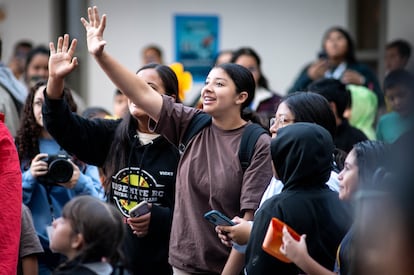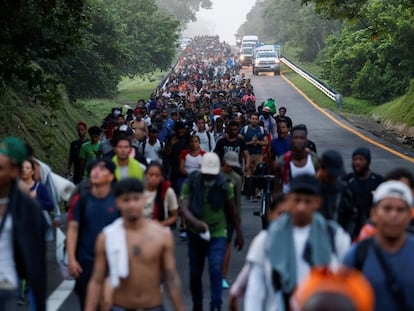Protecting undocumented students: How schools and colleges are responding to Trump’s second term
Educational institutions have issued statements to reassure students worried about deportation and immigration raids, promising not to share their data with federal authorities


Donald Trump’s immigration policies have already begun to cast a shadow over schools and universities across the United States, where educators and students are bracing for potential mass deportations. Fears of his campaign promise to deport millions of undocumented immigrants are spreading rapidly among students, families, and educational institutions, prompting them to send messages of reassurance.
The day after Trump’s resounding electoral victory on November 5, Michael S. Roth, president of Connecticut’s prestigious Wesleyan University, sought to calm concerns within his community. In a public statement, he pledged to protect vulnerable individuals: “The University will do everything it can to protect the most vulnerable among us. The mass deportations promised by president-elect Trump threaten our students who may be undocumented and are a cause of great concern to many in our community.”
Roth added that the Republican’s previous administration, during which 1.5 million deportations were carried out — with many families separated — had shed light on what may come, and that the college was preparing for the worst. “As we said after the election of 2016: Wesleyan will remain committed to principles of non-discrimination, including equal protection under the law, regardless of national origin or citizenship,” he said. “The University will not voluntarily assist in any efforts by the federal government to deport our students, faculty or staff solely because of their citizenship status. Today, the work to defend the most vulnerable has never been more important.”
Although Trump has stated that initial deportations will target individuals with existing removal orders or criminal records, his broader objective — supported by his team handpicked to lead immigration policy — is the removal of 11 million undocumented immigrants. This sweeping plan includes children in kindergartens and university students alike.
In theory, schools and colleges are categorized as “sensitive areas” — like hospitals and places of worship — meaning immigration enforcement actions are prohibited there. For instance, the superintendent of Montgomery County Public Schools (MCPS) in Maryland recently reminded families that schools are considered safe spaces. “ICE [Immigration and Customs Enforcement] treats schools as sensitive areas where arrests, interviews, searches or surveillance activities will not generally occur,” he stated, while also acknowledging the ongoing anxiety among immigrant communities. “We do not intend to cause unnecessary alarm in our school communities, but we want our families and students to know that we are working with other Montgomery County agencies and community organizations to prepare for any scenario.”
The conservative roadmap Project 2025, crafted by the Heritage Foundation, however, proposes eliminating such designations. Trump has publicly distanced himself from the plan’s most extreme measures, but his appointment of its architects — Tom Homan as “border czar” and Stephen Miller as deputy chief of staff — to lead immigration policy suggest a hardline approach.
Amid mounting concerns, the Presidents’ Alliance — which represents more than 500 higher education institutions — published a guide on ways in which campuses can support migrant students and employees. One of the five recommendations listed is releasing a public statement of support. They offer this sample: “We understand that this may be a period of uncertainty and anxiety for many on our campus and within our community. At [Institution Name], we want to reaffirm our strong and steadfast commitment to supporting our undocumented, refugee, and international students, along with other members of our campus. We remain committed to ensuring that our campus is a welcoming, inclusive space for all students, faculty, and staff.”
The organization also recommends holding informational workshops, distributing resource lists both on and off campus — including access to legal advice — and providing psychological support for students grappling with anxiety. Established in 2017, the group was created to protect participants in the DACA program, which permits migrants who arrived as children, known as Dreamers, to remain in the country. During his first term, Trump attempted to terminate the program, which is now in limbo, with its fate pending a court decision.
More than 400,000 college students nationwide are undocumented, and the Alliance estimates that about a third of them are eligible for DACA. In his second term, Trump aims to try again to eliminate the program, this time with stronger support from the judiciary after appointing several judges during his previous presidency, including three Supreme Court justices. The Supreme Court, which is expected to decide the future of DACA, currently has six conservative justices and three progressives
Immigrant students have been a crucial source of enrollment growth for U.S. colleges over the past two decades. The number of immigrant students increased by 78%, from 3.4 million in 2000 to nearly 6.1 million in 2021. This growth contrasts with the 22% increase in total college enrollment, from 15.3 million to 18.7 million, according to data from the Migration Policy Institute (MPI).
One of the ways schools and universities can protect their students is by safeguarding their data. Sonya Christian, president of California Community Colleges, received numerous concerns from campuses, which she responded to in a statement: “Our system does not capture information on undocumented students and our colleges will not release personally identifiable student information related to immigration status unless required by judicial order.”
Several universities, including UCLA, have issued similar statements, committing not to release student information.
Despite the guarantees provided by educational institutions and calls for reassurance, protections are still subject to state and federal laws. Some Republican-governed states criticize the financial burden that undocumented students place on public resources and push for removing their right to education. This right is upheld by the Supreme Court’s 40-year-old doctrine in Plyler v. Doe, which asserts that all children, regardless of their immigration status, are entitled to an education.
Oklahoma Superintendent of Public Instruction Ryan Walters has requested $474 million from the federal government to cover the costs of educating undocumented immigrants in the state’s public schools. “One of the biggest problems facing Oklahoma — or schools across the country, frankly — is illegal immigrants coming across the border, tapping the resources of taxpayers and stretching everything thin,” he said on Nov. 20.
Even without raids on educational institutions, the fear of arrests has led to increased truancy and pushed many families to relocate from areas where local authorities cooperate with immigration enforcement. A study from Stanford University found that during Trump’s first term, the number of Hispanic children in public schools in such areas dropped by 7.3%, with the most significant decline in elementary schools, where enrollment fell by 9.4%.
In Colorado’s largest district, Denver Public Schools, which serves about 85,000 students, board member Scott Esserman emphasized the importance of protecting students’ right to education, regardless of their background. “We will take care of you,” he said during a recent work session. “That’s our responsibility.”
Pro-immigrant organizations are already preparing to defend the community against potential legal actions from the new administration and are encouraging educational institutions to act before January 20, when the new executive will take office.
“It is very important to have conversations with city authorities, with the Police Department, even with the campus police, to have a plan and to explain to them that although there are certain lines that cannot be crossed, the safety of students is the most important thing and that includes migrants. These conversations have to start now, we must not wait until January, because building those relationships is going to be fundamental,” warns Gaby Pacheco, president of TheDream.us.
Sign up for our weekly newsletter to get more English-language news coverage from EL PAÍS USA Edition
Tu suscripción se está usando en otro dispositivo
¿Quieres añadir otro usuario a tu suscripción?
Si continúas leyendo en este dispositivo, no se podrá leer en el otro.
FlechaTu suscripción se está usando en otro dispositivo y solo puedes acceder a EL PAÍS desde un dispositivo a la vez.
Si quieres compartir tu cuenta, cambia tu suscripción a la modalidad Premium, así podrás añadir otro usuario. Cada uno accederá con su propia cuenta de email, lo que os permitirá personalizar vuestra experiencia en EL PAÍS.
¿Tienes una suscripción de empresa? Accede aquí para contratar más cuentas.
En el caso de no saber quién está usando tu cuenta, te recomendamos cambiar tu contraseña aquí.
Si decides continuar compartiendo tu cuenta, este mensaje se mostrará en tu dispositivo y en el de la otra persona que está usando tu cuenta de forma indefinida, afectando a tu experiencia de lectura. Puedes consultar aquí los términos y condiciones de la suscripción digital.
More information
Archived In
Últimas noticias
The complicated life of Francesca Albanese: A rising figure in Italy but barred from every bank by Trump’s sanctions
Half of Scotland is in the hands of 420 property owners
Pinochet’s victims grapple with José Antonio Kast’s rise in Chile
Reinhard Genzel, Nobel laureate in physics: ‘One-minute videos will never give you the truth’
Most viewed
- Pablo Escobar’s hippos: A serious environmental problem, 40 years on
- Why we lost the habit of sleeping in two segments and how that changed our sense of time
- Charles Dubouloz, mountaineering star, retires at 36 with a farewell tour inspired by Walter Bonatti
- Trump’s obsession with putting his name on everything is unprecedented in the United States
- The Florida Keys tourist paradise is besieged by immigration agents: ‘We’ve never seen anything like this’









































